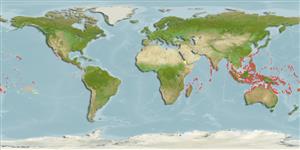>
Ovalentaria/misc (Various families in series Ovalentaria) >
Pomacentridae (Damselfishes) > Pomacentrinae
Etymology: Pomacentrus: Greek, poma, -atos = cover, operculum + Greek, kentron = sting (Ref. 45335).
More on authors: Evermann & Seale.
Environment: milieu / climate zone / depth range / distribution range
Ecologie
marien rifbewoner; standvastig; diepte 1 - 20 m (Ref. 7247). Tropical; 30°N - 23°S
Indo-West Pacific: Maldives to Rowley Shoals, New Caledonia,and north to the Ryukyu Islands.
Grootte / Gewicht / Leeftijd
Maturity: Lm ? range ? - ? cm
Max length : 10.0 cm FL mannelijk / geslacht onbekend; (Ref. 5525)
Dorsale zachte stralen (totaal): 13-15; Anale zachte stralen: 14 - 15; Wervels: 22 - 24. This species is distinguished by the following characters: an orange hue on the thorax and ventralmost part of the sides, and juveniles have an expanded yellow-to-orange zone posteriorly on the body, encompassing the soft dorsal and anal fins, caudal fin, and adjacent caudal peduncle (Ref. 114927).
Adults occur in lagoons, steep-sided channels, and seaward reefs from 2 to over 12 m (Ref. 1602). Usually found in groups off the sides of vertical drop-offs and overhanging ledges (Ref. 1602). Oviparous, distinct pairing during breeding (Ref. 205). Eggs are demersal and adhere to the substrate (Ref. 205). Males guard and aerate the eggs (Ref. 205). Diurnal species (Ref. 54980; 113699). Maximum depth reported taken from Ref. 128797.
Levenscyclus en paargedrag
Maturiteit | Voortplanting | Paaien | Eieren | Fecunditeit | Larven
Oviparous, distinct pairing during breeding (Ref. 205). Eggs are demersal and adhere to the substrate (Ref. 205). Males guard and aerate the eggs (Ref. 205).
Allen, G.R., M.V. Erdmann and P.D. Pertiwi, 2017. Descriptions of four new species of damselfishes (Pomacentridae) in the Pomacentrus philippinus complex from the tropical western Pacific Ocean. J. Ocean Sci. Found. 25:47-76. (Ref. 114927)
Status op de Rode Lijst van het IUCN (Ref. 130435)
Gevaar voor de mens
Harmless
Gebruik door de mens
Aquarium: Commercieel
Meer informatie
ReferentiesAquacultuurAquacultuurprofielKweeklijnenGeneticaElectrophoresesErfelijkheidZiektesVerwerkingNutrientsMassaconversie
Tools
Speciale rapporten
Download XML
Internetbronnen
Estimates based on models
Preferred temperature (Ref.
123201): 25.3 - 29.3, mean 28.4 °C (based on 2636 cells).
Fylogenetische diversiteitsindex (Ref.
82804): PD
50 = 0.5000 [Uniqueness, from 0.5 = low to 2.0 = high].
Bayesian length-weight: a=0.01778 (0.00993 - 0.03183), b=2.98 (2.82 - 3.14), in cm total length, based on LWR estimates for this species & (Sub)family-body (Ref.
93245).
Trofisch niveau (Ref.
69278): 2.7 ±0.29 se; based on food items.
Weerstandsvermogen (Ref.
120179): Hoog, minimale populatieverdubbelingstijd minder dan 15 maanden (Preliminary K or Fecundity.).
Fishing Vulnerability (Ref.
59153): Low vulnerability (10 of 100).
Nutrients (Ref.
124155): Calcium = 126 [70, 212] mg/100g; Iron = 0.834 [0.517, 1.318] mg/100g; Protein = 18.6 [17.6, 19.6] %; Omega3 = 0.138 [0.086, 0.220] g/100g; Selenium = 18.8 [10.9, 33.9] μg/100g; VitaminA = 144 [49, 433] μg/100g; Zinc = 2.2 [1.5, 3.0] mg/100g (wet weight);
